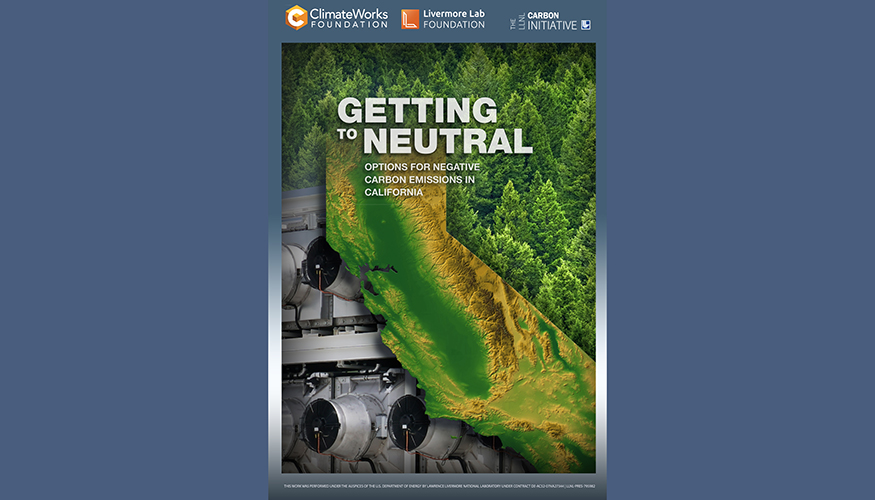From R&D to national lab/corporate partnerships, commercialization, and community engagement, Georgia Tech is at the forefront of developing and deploying negative emissions
technologies, such as direct air capture.
Tag: Carbon Capture and Storage
Light-activated acid drives energy-efficient, on-demand release of captured CO2
Using light instead of heat, Oak Ridge National Laboratory researchers found a way to release carbon dioxide from a solvent used in direct air capture to trap this greenhouse gas.
U.S. Department of Energy Announces $68 Million For Small Businesses Developing Technologies to Cut Emissions and Study Climate
The U.S. Department of Energy (DOE) today announced awards totaling more than $68 million that will go to 53 small businesses that are solving scientific problems. Projects include developing tools for climate research and advanced materials and technologies for clean energy conversion. Understanding the climate and the ability to convert and store energy are instrumental to meeting President Biden’s goal of a completely clean electrical grid by 2035 and net-zero greenhouse-gas emissions by 2050.
Can clay capture carbon dioxide?
A Sandia National Laboratories-led team of scientists has been using powerful computer models combined with laboratory experiments to study how a kind of clay can soak up carbon dioxide and store it.
Danforth Center and Salk plant researchers launch collaboration to breed carbon-capturing sorghum
Researchers at the Salk Institute’s Harnessing Plants Initiative have established a five-year, $6.2 million collaboration with Dr. Nadia Shakoor and her team at the Danforth Center to identify and develop sorghum plants that can better capture and store atmospheric carbon.
How crushed rocks can help capture CO2
IIASA researchers and international colleagues explored the potential of using finely ground rock to help with the removal of CO2 from the atmosphere on the road to achieving net-zero emissions and keeping global warming below 1,5°C.

What are the promises and perils of geoengineering?
In a new book, “Has It Come to This? The Promises and Perils of Geoengineering on the Brink,” Holly Jean Buck and colleagues weigh in on social, ethical and political dimensions of deliberate, large-scale interventions in the planet’s climate.

How to Tackle Climate Change, Food Security and Land Degradation
How can some of world’s biggest problems – climate change, food security and land degradation – be tackled simultaneously? Some lesser-known options, such as integrated water management and increasing the organic content of soil, have fewer trade-offs than many well-known options, such as planting trees, according to a Rutgers-led study in the journal Global Change Biology.
Making sense of climate scenarios: New toolkit available for decision makers
To make climate scenarios work for decision makers, an international team of researchers have developed a comprehensive interactive online platform.

California can become carbon neutral by 2045
Lawrence Livermore National Laboratory (LLNL) scientists have identified a robust suite of technologies to help California clear the last hurdle and become carbon neutral – and ultimately carbon negative – by 2045. This groundbreaking study, “Getting to Neutral: Options for Negative Carbon Emissions in California,” was conducted as part of LLNL’s expansive energy programs work and the Laboratory’s Carbon Initiative. The goal of the initiative is to identify solutions to enable global-scale CO2 removal from the atmosphere and hit global temperature targets.
New Investments and Research Indicate Multi-Trillion Dollar Market for Climate Restoration Through Carbon-Capture
Climate restoration is the global movement to remove the trillion tons of excess CO2 from the atmosphere to restore our air to preindustrial levels of carbon dioxide and to preserve the Arctic ice. Given the climate emergency, climate restoration is a critical third pillar of climate action, complementing ongoing mitigation and adaptation efforts. New technologies and natural solutions for reducing CO2 levels in the next 30 years already exist and the costs for global-scale implementation are projected to be less than 1-3% of the global annual GDP.
New Investments and Research Indicate Multi-Trillion Dollar Market for Climate Restoration Through Carbon-Capture
Climate restoration is the global movement to remove the trillion tons of excess CO2 from the atmosphere to restore our air to preindustrial levels of carbon dioxide and to preserve the Arctic ice. Given the climate emergency, climate restoration is a critical third pillar of climate action, complementing ongoing mitigation and adaptation efforts. New technologies and natural solutions for reducing CO2 levels in the next 30 years already exist and the costs for global-scale implementation are projected to be less than 1-3% of the global annual GDP.